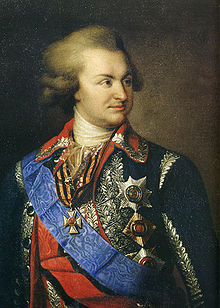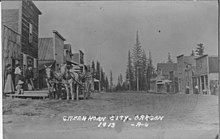
In politics and economics, a Potemkin village (/pɐˈtʲɵmkʲɪn/) is a construction (literal or figurative) whose purpose is to provide an external façade to a situation, to make people believe that the situation is better than it actually is. The term comes from stories of a fake portable village built by Grigory Potemkin, a field marshal and former lover of Empress Catherine II, solely to impress the Empress during her journey to Crimea in 1787. Modern historians agree that accounts of this portable village are exaggerated. The original story was that Potemkin erected phony portable settlements along the banks of the Dnieper River in order to impress the Russian Empress and foreign guests. The structures would be disassembled after she passed, and re-assembled farther along her route to be seen again.
Origin

Grigory Potemkin was a minister and lover of the Russian Empress Catherine II. After the 1783 Russian annexation of Crimea from the Ottoman Empire and "liquidation" of the Cossack Zaporozhian Sich (see New Russia), Potemkin became governor of the region. Crimea had been devastated by the war, and the Muslim Tatar inhabitants of Crimea were viewed as a potential fifth column of the Ottoman Empire. Potemkin's major tasks were to pacify and rebuild by bringing in Russian settlers. In 1787, as a new war was about to break out between Russia and the Ottoman Empire, Catherine II, with her court and several ambassadors, made an unprecedented six-month trip to New Russia. One purpose of this trip was to impress Russia's allies prior to the war. To help accomplish this, Potemkin was said to have set up "mobile villages" on the banks of the Dnieper River. As soon as the barge carrying the Empress and ambassadors arrived, Potemkin's men, dressed as peasants, would populate the village. Once the barge left, the village was disassembled, then rebuilt downstream overnight.
Historical accuracy
According to Simon Sebag-Montefiore, Potemkin's most comprehensive English-language biographer, the tale of elaborate, fake settlements, with glowing fires designed to comfort the monarch and her entourage as they surveyed the barren territory at night, is largely fictional. Aleksandr Panchenko, an established specialist on 19th-century Russia, used original correspondence and memoirs to conclude that the Potemkin villages are a myth. He writes: "Based on the above said we must conclude that the myth of 'Potemkin villages' is exactly a myth, and not an established fact." He writes that "Potyomkin indeed decorated existing cities and villages, but made no secret that this was a decoration".
The close relationship between Potemkin and the empress could have made it difficult for him to deceive her. Thus, if there were deception, it would have been mainly directed towards the foreign ambassadors accompanying the imperial party.
Although "Potemkin village" has come to mean, especially in a political context, any hollow or false construct, a facade, physical or figurative, meant to hide an undesirable or potentially damaging situation, it is possible that the phrase cannot be applied accurately to its own original historical inspiration. According to some historians, some of the buildings were real, and others were constructed to show what the region would look like in the near future, and at least Catherine and possibly also her foreign visitors knew which were which. According to these historians, the claims of deception were part of a defamation campaign against Potemkin.
According to a legend, in 1787, when Catherine passed through Tula on her way back from the trip, the local governor Mikhail Krechetnikov attempted a deception of that kind in order to hide the effects of a bad harvest.
Modern usage
Further information: Façade

In the Old West of the United States, Western false front architecture was often used to create the illusion of affluence and stability in a new frontier town. The style included a tall vertical façade with a square top in front of a wood-framed building, often hiding a gable roof. The goal for the architecture was to project an image of stability and success for the town, while the business owners did not invest much in buildings that might be temporary. These towns often did not last long before becoming ghost towns, so businessmen wanted to get started quickly but did not want to spend a lot on their stores. Many Western movies feature this kind of architecture because, just like the original buildings, it is quick and cheap to create.
As told in his book, The Gulag Archipelago, Aleksandr Solzhenitsyn declined to visit the Kriukovo Gulag with a Soviet official, seemingly chosen by the Soviets well in advance of their meeting, as Solzhenitsyn assumed it would be a "Potemkin structure".
Many of the newly constructed base areas at ski resorts are referred to as Potemkin villages. These create the illusion of a quaint mountain town, but are actually carefully planned theme shopping centers, hotels and restaurants designed for maximum revenue. Similarly, in The Geography of Nowhere, American writer James Howard Kunstler refers to contemporary suburban shopping centers as "Potemkin village shopping plazas".

Sometimes, instead of the full phrase, just "Potemkin" is used, as an adjective. For example, the use of a row of trees to screen a clearcut area from motorists has been called a "Potemkin forest". The glossary entry for "clearcut" in We Have The Right To Exist: A Translation of Aboriginal Indigenous Thought states that "Much of the extensive clearcut in northern Minnesota is insulated from scrutiny by the urbanized public by a Potemkin forest, or, as the D.N.R. terms it, an aesthetic strip – a thin illusion of forest about six trees deep, along most highways and fronting waters frequented by tourists." Another example is the phrase "Potemkin court", which implies that the court's reason to exist is being called into question (differing from the phrase "kangaroo court" with which the court's standard of justice is being impugned).
"Potemkin village" is a phrase that has been used by American judges, especially members of a multiple-judge panel who dissent from the majority's opinion on a particular matter, to refer to an inaccurate or tortured interpretation and/or application of a particular legal doctrine to the specific facts at issue. Use of the phrase is meant to imply that the reasons espoused by the panel's majority in support of its decision are not based on accurate or sound law, and their restrictive application is merely a masquerade for the court's desire to avoid a difficult decision. For example, in Planned Parenthood of Southeastern Pennsylvania v. Casey (1992), chief justice of the United States William Rehnquist wrote that Roe v. Wade "stands as a sort of judicial Potemkin Village, which may be pointed out to passers-by as a monument to the importance of adhering to precedent". Similarly, Judge William G. Young of the District of Massachusetts described the use of affidavits in U.S. litigation as "the Potemkin Village of today's litigation landscape" because "adjudication by affidavit is like walking down a street between two movie sets, all lawyer-painted façade and no interior architecture."
See also
- Theresienstadt (1944 film)
- Theresienstadt Ghetto and the Red Cross
- Czech Dream
- Disneyfication
- Potemkin Island
- Potemkin City Limits, an album by punk band Propagandhi
- The Truman Show
- Legends of Catherine the Great
- Novorossiya ("New Russia"), historical region in the Russian Empire
- Folly, architecture vernacular
- Fake building
- Façadism
- Sportswashing
- Kijong-dong
- Portmeirion, a folly tourist village, used as the filming location for the 1967 TV series The Prisoner
Notes
- Russian: потёмкинские деревни, romanized: potyomkinskiye derevni.
References
- "Grigory Potemkin | Biography, Villages, & Facts | Britannica". www.britannica.com. Retrieved 22 December 2021.
- ^ Norman Davies (30 September 2010). Europe: A History. Random House. pp. 658–. ISBN 978-1-4070-9179-2.
- Tharoor, Ishaan (6 August 2010). "Top 10 Weird Government Secrets". Time. ISSN 0040-781X. Retrieved 1 September 2017.
- "Did 'Potemkin villages' really exist?". The Straight Dope. 14 November 2003.
- Aleksandr Panchenko, "Potyomkin villages as a cultural myth", (rus) in Panchenko, O russkoi istorii i kul´ture (Saint-Petersburg, Azbuka, 2000), 416. "В связи с вышесказанным должно сделать заключение, что миф о «потемкинских деревнях» – именно миф, а не достоверно установленный факт."
- Aleksandr Panchenko, "Potemkinskie derevni' kak kul´turnyi mif", in Panchenko, O russkoi istorii i kul´ture (Saint-Petersburg, Azbuka, 2000), 416. "Потемкин действительно декорировал города и селения, но никогда не скрывал, что это декорации."
- Davies, Norman. Europe: A history, London, Pimlico, 1997, p. 658.
- Joseph A. Maxwell (8 June 2012). Qualitative Research Design: An Interactive Approach. SAGE Publications. pp. 139–. ISBN 978-1-4522-8583-2.
- "The Straight Dope: Did "Potemkin villages" really exist?". 14 November 2003. Retrieved 5 June 2016.
- Kulke, Ulli (28 February 2011). "Katharina die Grosse: An Fürst Potemkin war alles echt. Auch die Dörfer" [Everything about Prince Potemkin was real. Including the villages]. Die Welt (in German).
- "Русский литературный анекдот XVIII-XIX вв". fershal.narod.ru. 18 November 2010. Retrieved 20 March 2011.
- Clifford, Hal (2002). Downhill Slide: Why the Corporate Ski Industry is Bad for Skiing, Ski Towns, and the Environment. Sierra Club Books. pp. 106–110. ISBN 9781578050710.
- "Colorado Ski Areas – SKI BUM". Retrieved 22 March 2017.
- Kunstler, James Howard (1993). The Geography of Nowhere: The Rise and Decline of America's Man-Made Landscape. New York, Touchstone.
- "Humanity is waging an inexplicable war on trees. It's not going to work out for either side - Los Angeles Times". 2 May 2018.
- Wub-e-ke-niew. "We Have The Right To Exist: A Translation of Aboriginal Indigenous Thought". Maquah.net. Retrieved 15 November 2016.
- Shahabuddeen, Mohamed (1 November 2012). International Criminal Justice at the Yugoslav Tribunal: A Judge's Recollection. OUP Oxford. ISBN 9780191649851.
- Sinclair, Timothy J. (2004). Global Governance: Critical Concepts in Political Science, Volumen 1. Taylor & Francis. p. 56. ISBN 9780415276627.
- Planned Parenthood of Southeastern Pennsylvania v. Casey, 505 U.S. 833, 966 (29 June 1992) ("Roe v. Wade stands as a sort of judicial Potemkin Village, which may be pointed out to passers-by as a monument to the importance of adhering to precedent. But behind the façade, an entirely new method of analysis, without any roots in constitutional law, is imported to decide the constitutionality of state laws regulating abortion.").
- United States v. Massachusetts, 781 F. Supp. 2d 1, 22 n.25 (D.Mass 2011).
Bibliography
- EircomTribunal, "2003 Potemkin Village Award", EircomTribunal.com, "ET – 2003 Potemkin Village Award". Eircomtribunal.com. Archived from the original on 27 September 2007. Retrieved 20 March 2011.
- * Goldberg, Jonah. "Potemkin Village in Cuba: Let's make one of our own". National Review. 18 April 2000. Retrieved 25 October 2018. National Review, 19 April 2000.
- Ivan Katchanovski and La Porte, Todd. "Cyberdemocracy or Potemkin E-Villages? Electronic Governments in OECD and Post-Communist Countries", International Journal of Public Administration, Volume 28, Number 7–8, July 2005.
- Ledeen, Michael. "Potemkin WMDs? Really?", National Review, 2 February 2004 "Michael Ledeen on WMDs & Iraq on National Review Online". National Review. 2 February 2004. Retrieved 20 March 2011.
- Smith, Douglas (ed. and trans). Love and Conquest: Personal Correspondence of Catherine the Great and Prince Grigory Potemkin ISBN 0-87580-324-5
- Potemkin Court as a description of The Foreign Intelligence Surveillance Court (from the Washington Post)
- Potemkin Parliament as a description of the European Parliament (New Statesman, 20 September 2004)
- Sullivan, Kevin. "Borderline Absurdity", Washington Post, 11 January 1998.
- Buchan, James. "Potemkin democracy" as a description of Russia. "New Statesman", 17 July 2006.
External links
- New York Review of Books, "An Affair to Remember", review by Simon Sebag Montefiore of Douglas Smith, Love and Conquest: Personal Correspondence of Catherine the Great and Prince Grigory Potemkin
- Smith, Douglas. Love and Conquest: Personal Correspondence of Catherine the Great and Prince Grigory Potemkin